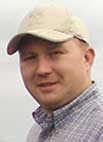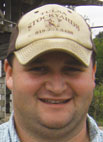
Joe Bob Staton grew up in the shadow of Mt. Magazine. He always knew that he wanted to farm. When he married Carrie Isaacs almost 11 years ago, they started out on their own with 17 cows on a few rented acres. Since then, the commercial beef herd has grown to 120 cows on over 400 acres that they own and lease a mile or two from his dad’s Lazy S Ranch.
Before Joe Bob started teaching Animal Science and Mechanics at Magazine School District he was a field man for OK Foods. Carrie worked for OK until she took some time off to be with their children. Now, she is a pre-K teacher for Magazine’s ABC program.
A Family Affair
The Staton farm is a family effort all the way from Joe Bob down to 5-year-old Ethan (picture above, left inset), who even helps with feeding. “Carrie cuts and rakes hay, feeds cows and everything,” said Joe Bob. Sometimes not as much as I’d like," he teased. “And sometimes more than I like,” laughed Carrie.
The Statons’ three children each have their own 4-H projects. Adrian, 9, has shown pygmy goats and pigs at the county fair. This year she is planning to add a Nubian goat to her projects. Emily, 7, showed her first pig, that she named Candy Bar, when she was five years old. She also has chickens and goats and will participate in the 4-H Pullet Chain project. Ethan is eager to get started on his projects, and will have a pig, a pygmy goat and pullets to show.
Satellite Marketing
Joe Bob explained that using televised auctions has been very instrumental in their growth.
“We started out selling our cattle at local sale barns, but we weren’t getting very good prices,” he said. “About five years ago we started selling the majority of our calves on Superior Livestock Auctions. We have been getting top of the market price,” he said. “A Superior rep comes out and films the calves. The calves are assigned lot numbers by type, expected weight, and day of sale. A catalog advertising the sale is published. Buyers watch the auction by satellite on RFD TV and call in to bid.”
According to Carrie about 25 percent of the calves are born too late to make the weight requirements in time and so they are sent to Oklahoma City, Okla.
Farm Management
“We want black hides and we try to keep replacements that will keep our cows small. Smaller cows eat less and wean more pounds per calf. You can run more small cows and wean more pounds gross per herd than larger cows,” said Joe Bob.
“We would like to work toward buying more land and increasing the cow herd. Finding land has been one of the biggest challenges. I would run 200 cattle if I had the land,” he said.
“The home place is improved pasture, mostly Bermuda. The rented acres are native grasses. We are trying to improve pasture on all of the land, with fertilizer and chicken litter. It’s getting harder with the high price of fertilizer, he related. We do rotational grazing in the summer time. It cuts down on fertilizer requirements and pastures stay fresher. The cows spend three days on each 20 to 40-acre lot," explained Joe Bob. “We are trying to put up more permanent fences for the rotational grazing,” added Carrie.
Community Servants
The Statons were presented the Farm Bureau Young Farmers & Ranchers Excellence in Agriculture Award in November 2007 and represented the state at the national competition in New Orleans, La., in January.
Their experience, work with many local organizations and resilience in the agriculture industry made them prime candidates for the award, as well as for continued success in this farming business.







